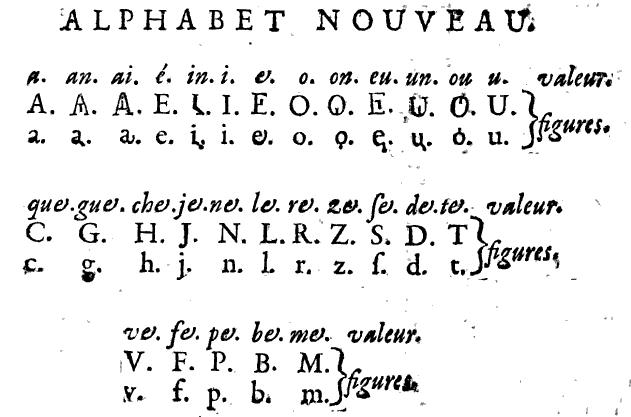Where does this alphabet come from?
It comes from Ortofasil (version 0) website. Of course, another alphabet could be used.
What are the qualities of this alphabet?
- It is close to the historical alphabet of French language.
- It is phonetic (one letter corresponds to one single sound, and vice-versa).
What are the defects of this alphabet?
- 9 letters contain an accent (ã, é, è, ë, ĩ, j̃ , õ, ö, ũ).
- 1 letter has a new use (c).
What would be the ideal phonetic alphabet for the French writing system?
An idea alphabet would require an alphabet having the above qualities without having the defects mentioned above.
What is the main defect of a phonetic writing system for French language?
The mais difficulty is with words having the same pronunciation but having a different orthography. For example, without more information on the context, it's impossible to differenciate so (seau) from so (sot). However, if French orthography can deals with a same written word for cruche (a container) and cruche (a person) , it wil require to do the same with words like so (a container) and so (a person).What is the pronuciation of reference?
The pronunciation of reference used in our phonetic system is based on the pronunciation suggested by Le Petit Robert.Local variants are allowed but not used by the tools of this website.
Do double consonnant still exist?
No. In the approach retained here, a word never contains a double consonnant. For example : kolon for colonne, kolin for colline, dezyèmã for deuxièmement.What is sign h used for?
In the "phonetic" writing system, sign h prevents a liaison when reading the text.- It prevents a liaison with the preceeding word. For instance, there is no liaison in lé hobã (les haubans) as h is not a vowel ; However, there is a liaison in léz abi (les habits) as a is a vowel.
What is letter j̃ used for?
The letter j̃ is used for onle four French words : azulejo azouléj̃ o, jota j̃ ota, khamsin j̃ amsin and mudéjar moudéj̃ ar.
Why not using the International Phonetic Alphabet (IPA)?
- The lettters used in this website are more easily readable by a French person.
- Moreover, The IPA does not differenciate lower case from upper case.
What is the mapping with the International Phonetic Alphabet (IPA)?
Most people don't need to read this section, which adds additional information for experts in phonetics
| Fonétik Letter | IPA Letter | Examples of words in orthographe | Fonétik Letter | IPA Letter | Examples of words in orthographe | |
| a | a or ɑ | ami, pâté | m | m | moi, mère | |
| ã | ɑ̃ | élan, pantalon | n | n | né, natif | |
| b | b | bébé, baobab | o | ɔ or o | or, joli | |
| c | ʃ | cheval, char | õ | ɔ̃ | ton, bonbon | |
| d | d | dodo, dé | ö | u | fou, soupe | |
| e | ø or ə | peu, premier | p | p | papou, okapi | |
| é | e | été, bébé | r | ʀ | roi, rire | |
| è | ɛ | forêt, béret | s | s | sur, sale | |
| ë | œ | peur, soeur | t | t | ton, tutu | |
| f | f | fée, fou | u | y or ɥ | lu, lui | |
| g | g | gai, gué | ũ | œ̃ | un, lundi | |
| i | i | il, île | v | v | vélo, wagon | |
| ĩ | ɛ̃ | brin, tintin | w | w | wifi, wok | |
| j | ʒ | judo, jupe | y | y | yéti, yoga | |
| j̃ | x | jota, azulejo | z | z | zéro, zébu | |
| k | k | koala, okapi | ||||
| l | l | livre, lame | n+g | ŋ | ping pong | |
| h | ' | hauban | n+y | ɲ | gagné, nié |
- group some similar sounds in the same elementary sound.
- a and ɑ are each transcoded with letter a.
- ø and ə are each transcoded with letter e.
- ɔ and o are each transcoded with letter o.
- y and ɥ are each transcoded with letter u.
- transcode some precise sound with two similar sounds.
- ŋ is transcoded with letters n and g.
- ɲ is transcoded with letters n and y.
Are there some examples of phonetic writing system ?
Yes : Pinyin for Chinese, Kana for Japanese, Turkish, Korean, Italian, Spanish, Russian, Arabic... even if they contain very few exceptions.
Are there other references about a phonetic writing system for French?
Yes: one can look at the book Nouvelle Manière d'écrire, comme on parle en France, written by Gile Vaudelin, which already proposed a phonetic writing system in 1713.

In 1851, Adrien-Benjamin Féline also proposed a similar proposal in Dictionnaire de la prononciation de la langue française, indiquée au moyen de caractères phonétiques ; précédé d'un mémoire sur la réforme de l'alphabet.
